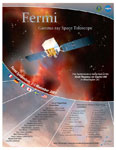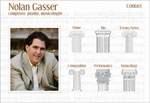
November 2, 2009
Celebrating the Success of the Fermi Telescope with a Musical Offering
The music of the spheres will take on a new meaning during the 2009 Fermi International Science Symposium to be held in Washington, D.C. , Nov. 2-5, 2009, looking back on the first year of spectacular results from the Fermi Gamma-ray Space Telescope (formerly known as GLAST). Stanford University and the SLAC National Accelerator Center were the lead institutions in the international Large Area Telescope collaboration that designed and built the instrument, under the direction of Stanford astrophysicist, Peter Michelson, Principal Investigator for the Fermi Large Area Space Telescope project and also Director of Stanford’s Hansen Experimental Physics Lab (HEPL).
A Public Concert
An extraordinary highlight of this science symposium will be a live, public concert, hosted by actress Alfre Woodard, on Nov. 2nd at the John F. Kennedy Center for the Performing Arts in Washington, D.C. This concert, produced and sponsored by Pierre Schwob, founder and CEO of Classical Archives in Palo Alto, Ca., will feature two works by composer Nolan Gasser (Stanford Ph.D. in Musicology, 2001)—GLAST Prelude, Op.12, for brass quintet and the World Premiere of Cosmic Reflection: A Narrated Symphony, Op.15. During the first half of the concert, the American Brass Quintet will perform the GLAST Prelude, which Classical Archives commissioned Gasser to compose in celebration of the Fermi telescope’s launch in June 2008. In the second half, the Boston University Symphony Orchestra, conducted by David Hoose, will perform the 40-minute Cosmic Reflection symphony, which Stanford and Classical Archives jointly commissioned Gasser to compose in celebration of the Fermi telescope’s first year results. British actor/playwright Carey Harrison will narrate the symphony. In addition, synchronized video images, produced by Rich Melnick at NASA’s Goddard Space Flight Center, will accompany the performances of both Gasser’s Prelude and Symphony.
Origins of Celebratory Musical Compositions for the Fermi Telescope
The commissioning of Gasser to compose first the GLAST Prelude and now the Cosmic Reflection is the result of long-standing friendships between Michelson and Schwob and between Schwob and Gasser; a close collaboration between the three men has culminated in this concert. Michelson emphasizes that: “…it is important that the public be able to share in the joy and excitement of scientific discovery; music is a wonderful means of doing that.” He came upon this notion of using music to celebrate the results of scientific discovery 12 years ago through an interesting set of circumstances and connections.
Peter Michelson is the grand nephew of Albert Michelson, who along with Edward Morley in 1887 created the first interferometer to experimentally measure the effects of the luminous aether, which at that time was believed to be the medium through which light travels. Of course, the now historic Michelson-Morley experiment found no evidence of an aether, thus revealing that the speed of light is constant and paving the way for Einstein’s special and general theories of relativity. Peter Michelson attended the 100th anniversary celebration of the Michelson-Morley experiment in 1997 at Case Western Reserve University in Cleveland, Oh. The scientific presentations commemorating the experiment were held in the Cleveland Symphony Hall, punctuated that evening by the world premiere performance of a symphony entitled “The Light,” by composer Philip Glass. Peter Michelson recalls:
“This was Philip Glass’s musical version of the Michelson-Morley experiment. For me, it just fit beautifully. You could kind of hear the light sloshing around in the interferometer…. It was a union between music and science that I thought was fascinating.”
And so, about a year before the Fermi [GLAST] telescope was scheduled to launch into orbit, Michelson approached his friend, Pierre Schwob, an amateur cosmologist with a passion for music and the arts, about the possibility of his commissioning a musical offering to be played on the occasion of the Fermi launch. Schwob thought this was a splendid idea, but knowing something of the logistical issues and inevitable delays surrounding satellite launches, he suggested that perhaps a shorter brass prelude be commissioned to celebrate the launch, followed a year later by a full orchestral symphony that “tells the story of the universe, as we now know it, based on scientific research and discovery.” Schwob further suggested that the prelude could be pre-recorded and played during a celebratory event immediately following the launch, but he had a more “cosmic” plan in mind for the symphony:
“We need to have some kind of celebration of this marriage of science and the arts. My ultimate goal, really, is to educate the public, the press and our government in supporting what our scientists are doing. So, I thought that in addition to this prelude, a year after the launch, when Fermi announces the results of the first year’s data collection, I would rent the concert hall in the Kennedy Center for the Performing Arts in Washington, D.C., and put on a big evening. Not only would the prelude be played again—live this time—but also this would be the world premiere of a cosmic symphony, the narration of which I want to write together with my friend, Lawrence Krauss.”
Lawrence Krauss, a well-known physicist who has authored several popular books on physics, including “The Physics of Star Trek,” was happy to participate, and he agreed to write a scientific description of the history of the universe from the Big Bang to present times, which Schwob would then transform into a poetic narrative that would become the basis for the Fermi symphony, which Schwob dubbed “Cosmic Reflection.”
The GLAST Prelude
Michelson heartily embraced this plan, and he and Schwob began discussing possible composers. Schwob recommended his friend and associate, Nolan Gasser, who also serves as the staff musicologist and artistic director at Classical Archives. Having met Gasser through Schwob, Michelson assented, and Gasser began work on composing the prelude. When he started composing the prelude, Gasser admittedly knew very little about physics, astronomy or cosmology, nor about the process of building and launching a space-borne telescope. But, he had Schwob’s extensive science library at his disposal and ready access to Michelson. Furthermore, Gasser, Michelson and Schwob traveled to NASA’s Goddard Space Flight Center to visit with other Fermi project scientists and also with the Goddard video and animation team, particularly video producer, Rich Melnick. This trip provided Gasser with invaluable insights into the history and science of the Fermi project. Armed with this knowledge, he plunged enthusiastically into the process of researching and composing the Prelude.
In telling the story of how he created the Prelude, Gasser recalls:
“For the Prelude, my idea was to [musically] take the listener to the launch of the Fermi space telescope, conveying all the excitement that goes with it. The countdown starts and then gets interrupted while the science and technology of the mission is portrayed in a series of musical episodes. There’s even a counterpoint of various national anthems, representing the international collaboration. The music then returns to complete the launch, and the finale portrays the telescope going into orbit, opening its solar panels and beginning its scientific quest.”
A Classical Music Video
From his meetings with the video and animation team at NASA’s Goddard center, Gasser, realized that photos and video of the Fermi telescope, launch preparation, stars, galaxies and so on, displayed along with his musical prelude, would add yet another sensory dimension to the composition, broadening its public appeal and understanding. Thus, after completing the Prelude, Gasser collaborated closely with Rich Melnick at NASA’s Goddard Center in creating a video to accompany the music. The ultimate result was a classical “music-video,” with the prelude recorded by the American Brass Quintet and the video images precisely synchronized with the music. The GLAST Prelude was presented June 6, 2008 to an audience of NASA and Fermi [GLAST] scientists and engineers at a reception in Cocoa Beach, Fla., prior to launch. The debut, co-sponsored by General Dynamics and Stanford University, received rave reviews. It has been downloaded/viewed over 100,000 times on the Web and is currently available free on various web sites, including Classical Archives (http://www.classicalarchives.com/prs/glast_prelude.html).
The Cosmic Reflection Symphony
While the Fermi telescope began transmitting gamma-ray data back to Earth, providing Michelson and the Fermi team unprecedented new information about supermassive black-hole systems, the origin of cosmic rays, pulsars, and much more, Schwob, Krauss and Gasser began work on their “magnum opus, the Cosmic Reflection symphony. For the prelude, Gasser composed the story line in his music; for the symphony, Krauss and Schwob’s narrative—a complete history of the universe in 40 minutes—provided the story line, which Gasser would portray musically, and Melnick in video. For Gasser, it was “the challenge of a lifetime” to understand and musically depict the story of our universe. He elaborates:
“…I had to come up with concrete musical depictions of concepts like inflation, separation of the forces, annihilation of matter by anti-matter, proton formation, and so on. How does one musically depict up quarks and down quarks? It was important that the piece be not just a musical scientific exercise; rather, I wanted to convey the aesthetic, philosophical and expressive wonder of the story. So, woven throughout the work, there are musical themes corresponding to the narrated themes—for example, a birth of the universe theme, a star theme, a galaxies theme, and a life theme that permeates the entire third movement. These themes are intended to help the listener make the connection that space isn’t just something out there. Rather, we are space! As the narration says: We are the children of the stars and grand children of the Big Bang.”
In the video/animation studio at Goddard Space Flight Center, Rich Melnick also had his work cut out for him. No other institution in the world has a better image archive than NASA for illustrating a complete history of the universe. For Rich, the challenge was selection and synchronization of the imagery to flow seamlessly with the music and the narration. Furthermore, as Nolan Gasser points out, the biggest synchronization challenge may fall on the shoulders of Maestro David Hoose on the evening of Nov. 2nd, when he steps to the podium to conduct live his Boston University Symphony Orchestra, in coordination with a live narration by Carey Harrison and a recorded video from Rich Melnick. “This whole performance, itself, is a grand experiment,” says Gasser.
A Grand Musical Experiment
A grand experiment, indeed. Pierre Schwob says:
"Cosmic Reflection is an expression of my awe for the heroic efforts of our scientists to understand our Universe, our place in it, and of the extraordinary talent and dedication of all those involved in our cultural heritage. We hope this unique merging of art and science will help inspire even greater love of classical music, and the understanding of the world around us. We are honored to be able to present the story of the universe in such a novel way, just as we are bringing music lovers the universe of classical music on our site every day.”To which, Peter Michelson adds:
“Music, science and the visual arts as well are closely connected—both intellectually and emotionally—to the excitement of discovery in fundamental research. The creativity of people like Lawrence and Pierre, who wrote the narration, or Nolan, who composed this symphony, or Rich who put together the video to illustrate the science is closely connected to the excitement we feel as scientists in looking at data from the Fermi telescope.”
Public Availability of Tickets
Tickets to the Cosmic Reflection concert evening are available to the general public through the Kennedy Center box office for $20. A limited number of free tickets have been made available for Stanford students, faculty, staff, and alumni (call Nancy Christiansen at 650-387-9742 for more information about tickets for the Stanford community).
—Story by Bob Kahn, HEPL Communications Consultant & Webmaster







